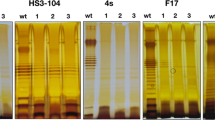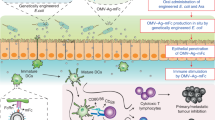Abstract
THE ability of cultured Entamoeba histolytica to cause ulcers in the caecum of guinea pigs and rats or abscesses in the liver of the Syrian hamster decreases rapidly on elimination of the accompanying bacterial flora1–4. It seemed that some strains grown axenicailly on TP-S-1 medium5 for many years had lost their pathogenicity entirely. When very large inocula were used, however, (107 amoebae), a granulomatous lesion was evoked in the hamster liver6,7. Our experiments with strains made freshly axenic, isolated from patients with amoebic dysentery, suggested that the number of amoebae required to induce a certain extent of pathology in the hamster liver increased with the number of transfers in axenic culture8. After a long period of axenic growth, strains probably maintain a very low degree of pathogenicity. Using two such strains, HK-9 and HB-301, we obtained results which may contribute to the understanding of the pathogenicity of E. histolytica. We were aible to restore the virulence of the HK-9 strain with cholesterol and establish a higher degree of virulence by two successive passages through hamster liver (HK-9H>2). In vitro toxicity towards guinea pig leukocytes, and agglutinability induced by concanavalin A (con A) were markedly greater in strain HK-9H2 than in HK-9. Antigenic analysis revealed a pattern for HK-9H2, different from that of the HK-9 strain.
This is a preview of subscription content, access via your institution
Access options
Subscribe to this journal
Receive 51 print issues and online access
$199.00 per year
only $3.90 per issue
Buy this article
- Purchase on Springer Link
- Instant access to full article PDF
Prices may be subject to local taxes which are calculated during checkout
Similar content being viewed by others
References
Phillips, B. P., and Bartgis, I. L., Am. J. trop. Med. Hyg., 3, 621–627 (1954).
Phillips, B. P., Diamond, L. S., Bartgis, I. L., and Stuppler, S. A., J. Protozool., 19, 498–499 (1972).
Wittner, M., and Rosenbaum, R. M., Am. J. trop. Med. Hyg., 19, 755–761 (1970).
Bos, H. J., Acta leidensia, 40, 1–111 (1973).
Diamond, L. S., J. Parasit., 54, 1047–1056 (1968).
Tanimoto, M., Sepúlveda, B., Vázquez-Saavedra, J. A., and Landa, L., Arch. inv. Méd., Mex., 2, Suppl. 1, 275–284 (1971).
Diamond, L. S., Phillips, B. P., and Bartgis, I. L., Arch. inv. Méd., Mex, 4, Suppl. 1, 99–104 (1973).
Bos, H. J., and Hage, A. J., Z. Parasitkde., 47, 79–89 (1975).
de Kruyff, B., Demel, R. A., and van Deenen, L. L. M., Biochim. biophys. Acta, 255, 331–347 (1971).
Sharma, R., Trans. R. Soc. trop. Med. Hyg., 53, 278–281 (1959).
Neal, R. A., and Stewart, A. Trans. R. Soc. trop. Med. Hyg., 54, 282–283 (1960).
Jarumilinta, R., and Kradolfer, F., Ann. trop. Med. Hyg., 58, 375–381 (1964).
Eaton, R. D. P., Meerovitch, E., and Costerton, J. W. Trans. R. Soc. trop. Med. Hyg., 63, 678–680 (1969).
Martinez-Palomo, A., Gonzalez-Robles, A., and de la Torre, M., Nature new Biol., 245, 186–187 (1973).
Author information
Authors and Affiliations
Rights and permissions
About this article
Cite this article
Bos, H., VAN DE GRIEND, R. Virulence and toxicity of axenic Entamoeba histolytica. Nature 265, 341–343 (1977). https://doi.org/10.1038/265341a0
Received:
Accepted:
Issue Date:
DOI: https://doi.org/10.1038/265341a0
This article is cited by
-
The dynamic interdependence of amebiasis, innate immunity, and undernutrition
Seminars in Immunopathology (2012)
-
Elicitation of protective immunity to Entamoeba histolytica — an experimental study
Immunology & Cell Biology (1987)
-
Lectin-induced agglutination of trophozoites of different species and strains ofEntamoeba
Zeitschrift f�r Parasitenkunde Parasitology Research (1984)
-
Lipid requirements for axenic cultivation ofEntamoeba histolytica
Journal of Biosciences (1980)
-
Experimental muscular amebiasis in hamsters as a biological model
Zeitschrift f�r Parasitenkunde Parasitology Research (1978)
Comments
By submitting a comment you agree to abide by our Terms and Community Guidelines. If you find something abusive or that does not comply with our terms or guidelines please flag it as inappropriate.



